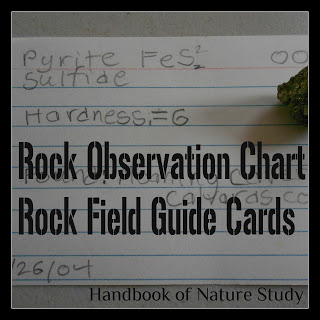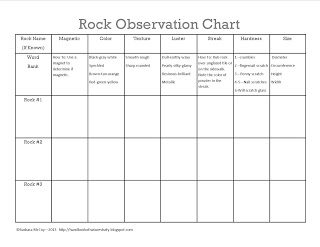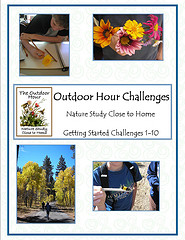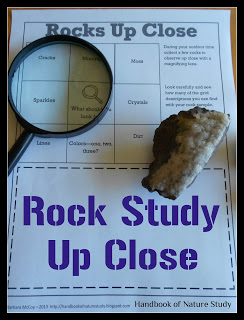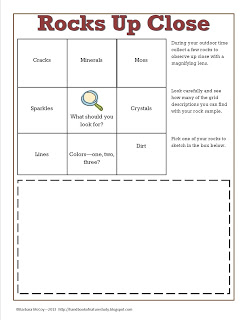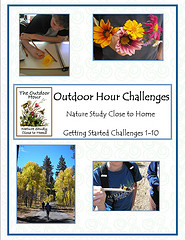This month you all surprised me with the number and variety of entries submitted for the rock related challenges. Your families are out there doing some great nature study even in the middle of winter. Thank you for continuing to inspire me to be outside as well. We have had a really cold month here in our neck of the woods and I could just as easily slacked off going outside. Instead, I was out there like the rest of you looking at rocks and learning so much more than I thought I could.
Our families rock entries from this month’s study (in case you missed one):
Our Rock Grid Study – Rocks for Our Collection
Top 5 Ways to Display Rocks
Rock Observations January 2013
Be inspired. Be encouraged. Get outdoors!
 |
| Lisa and her kids are on a rock study adventure |
Rock Grid Study
Desiree from Our Homeschool Notebook has a fantastic entry showing so many of their rock related activities from this month’s Rock Grid Study. I really enjoyed seeing how the incorporated so many of the grid study and newsletter suggestions.
Shirley Ann from Under An English Sky shares their unfolding rock-related nature study in her entry: Rock Study Grid. I think this is a great example of how you can find something interesting to learn about by just choosing a few of the grid suggestions and getting started. Thanks Shirley Ann!
Lisa from Pilgrims at Tinker Creek shares their two rock study entries in January Nature Walk and Rock Walk. They found lots of rocks very close to their home…love the striped one! She would love some help identifying some of their rocks if you are familiar with Virginia geology.
Robin from Academia shares their Geodes with the carnival. Looks like Tabbi got a great collection from this activity!
Angie from Petra School’s January Nature Study: Rocks entry is a delight! She shares not only her thoughts on rocks but nature study in general and I think you will find it very encouraging.
Diana from Homeschool Review shares their Nature Study #2 2013 entry with carnival readers. They were on the lookout for rocks but also share their mid-winter nature walk discoveries. Thanks for showing us you finds!
Tricia from Hodgepodge found a unique place to observe some local rocks – the State Capitol! Read all about it in Georgia Rocks Nature Study. Now that was resourceful!
Carla from Inside Outside Michiana shares their awesome Rock Grid Study entry with the carnival. Wow! You are going to love seeing all the great things they accomplished using the grid ideas. Check out their rock stacking!
Nadene has written a thoughtful post relating their Rocks and Stones Experience for the carnival. They took a more relaxed approach to their rock study and were delighted with the results.
 |
| Angie from Petra School – stacking rocks |
Rock Collection
Angie from Petra School has submitted their Rocks-Collecting By Type entry for the carnival. Wow! You are going to love seeing how her more advanced students took the grid study to a new level. I am inspired!
Robin from Academia share Tabbi Rocks! with carnival readers. She writes about Tabbi’s collection and the ones they borrowed to look at as part of this month’s rock challenges. Excellent idea to share collections!
Carla joins the carnival with their Start a Rock Collection entry from her blog Inside Outside Michiana. Even her littlest guy was able to participate in this challenge with great success! Related to this entry, Carla shares some additional insights about The Power of Their Own Stuff.
Michelle from Following Footprints had a great rock month and she shares their activities in their entry: Outdoor Hour Challenge-Our Rock Collection. They made a rock sculpture in the middle of their dining room table each day…fantastic idea! Don’t miss their journals too!
Sarah from GranWood Explores writes about their Outdoor Hour Challenge-Rocks and Minerals activities for the carnival. They made an excellent display of their rock collections with labels.
 |
| Michelle’s kids are off on a rock walk with Dad – pockets and pretty purse ready for collecting 3 rocks! |
Rock Up-Close
Angie from Petra School comes through with an awesome entry for Rocks Up Close! I invite you to click over and be inspired by her thoughts and images. Love her Oregon Coast geology!
Angie also submitted their Rock Observation Chart study…this one is going to show you just how to use that free printable from this month. Make sure to check out all the amazing colors of rocks!
Leslie from Mother Robin’s Notes from the Nest has written about their Rocks Up Close and Personal. What a wonderful entry showing the process they used in completing this rock related study. If you have trouble drawing rocks, you will appreciate this entry.
Nicole from Journey to Excellence seized the opportunity to complete their Rock Study – Perfect Indoor Sick Day Nature Study. She shares how they collected their rocks on one day and then observed them up close on another.
Sara from Garner Goings On submits her entry: Digging Into Rocks. They decided to focus on the rock cycle and to try to identify several rocks in their collection. She also recommends several rock themed books for you to check out.
Rock – Granite/Quartz
Leslie from Mother Robin’s Notes from the Nest wrote their entry It’s Gneiss to Meet You and she packed in a lot of interesting things about their local rocks…with a bit of humor. 🙂
Potpourri
Jennifer of Royal Little Lambs shares their Winter Nature Walk since all their rocks are under the snow. They found lots of great things to observe instead including some bright red rosehips! Make sure to see her new nature display box and nature notebook pages too.
Diane from Homeschool Review has written up their month’s study of mistletoe: Nature Walk 1-2013. I love seeing families follow their interest and learn about things they have in their own area. She also shares her son’s lovely images of snowflakes in Snow! Click over to see for yourself.
Don’t forget to share your blog entries with the Outdoor Hour Challenge Blog Carnival. All entries done in February are eligible for the next edition. The deadline for entries is 2/27/13 and you can send them directly to me: ha*************@***oo.com or submit them at the blog carnival site (link on the sidebar of my blog).







